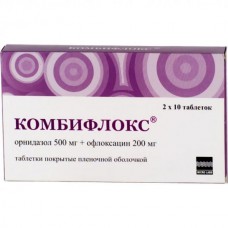Expiration date: 01/2025
Clinico-pharmacological group
(Antiprotozoal drug with antibacterial activity)
Release form, composition and packaging
3 PCs - blister al/al (1) - packs of cardboard.
5 PCs - blister al/al (1) - packs of cardboard.
10 PCs - blister al/al (1) - packs of cardboard.
10 PCs - blister al/al (2) - packs of cardboard.
10 PCs - blister al/al (10) - packs of cardboard.
Pharmacological action
Combination drug whose action caused by components that are part of it.
Ornidazole is Antiprotozoal and antibacterial agent, a derivative of 5-nitroimidazole. The mechanism of action consists in biochemical restoration of 5-nitro group of Ornidazole intracellular transport proteins anaerobic bacteria and protozoa. Restored 5-nitro group of Ornidazole interacts with DNA cells of microorganisms by inhibiting the synthesis of their nucleic acids, leading to death of bacteria.
Active against Trichomonas vaginalis, Giardia lamblia, Entamoeba histolytica, as well as anaerobes Bacteroides spp. (including Bacteroides fragilis, Bacteroides distasonis, Bacteroides ovatus, Bacteroides thetaiotaomicron, Bacteroides vulgatus), Fusobacterium spp., Clostridium spp. To Ornidazole is not sensitive aerobic microorganisms.
Ofloxacin is an antimicrobial agent broad spectrum of action of the fluoroquinolone group, which acts on the bacterial enzyme DNA girazu providing sverzellati and thus the stability of the DNA of bacteria (destabilization of the DNA strands leads to their death). Has a bactericidal effect.
Antimicrobial spectrum includes gram-positive aerobes:Staphylococcus aureus (methicillin sensitive), Staphylococcus epidermidis (methicillin sensitive), Staphylococcus saprophyticus, Streptococcus pneumoniae (penicillin sensitive), Streptococcus pyogenes.
Gram-negative aerobes: Acinetobacter calcoaceticus, Bordetella pertussis, Citrobacter freundii, Citrobacter koseri, Enterobacter aerogenes, Enterobacter cloacae, Escherichia coli, Haemophilus ducreyi, Haemophilus influenzae, Klebsiella oxytoca, Moraxella catarrhalis, Morganella morganii, Klebsiella pneumoniae, Neisseria gonorrhoeae, Proteus mirabilis, Proteus vulgaris, Providencia rettgeri, Providencia stuartii, Pseudomonas aeruginosa (quickly develop resistance), Serratia marcescens.
Anaerobes: Clostridium perfringens.
Other: Chlamydia trachomatis, Chlamydia pneumoniae, Gardnerella vaginalis, Legionella pneumophila, Mycoplasma hominis, Mycoplasma pneumoniae, Ureaplasma urealyticum.
In most cases insensitive: Nocardia asteroides, anaerobic bacteria (including Bacteroides spp. Peptococcus spp., Peptostreptococcus spp., Eubacterium spp., Fusobacterium spp., Clostridium difficile), Enterococcus spp., most Streptococcus spp. no effect on Treponema pallidum.
Pharmacokinetics
Suction:
Like ofloxacin and Ornidazole are well absorbed from the gastrointestinal tract after oral administration. Bioavailability is 90% (Ornidazole) - 95% (ofloxacin). Connection with plasma proteins - 13% (Ornidazole) - 25% (ofloxacin). Dmah - 1-2 h, Ornidazole - 3 hours.
Distribution:
Ofloxacin: the apparent volume of distribution - 100 l. Distribution: cells (leukocytes, alveolar macrophages), skin, soft tissue, bone, abdominal organs and pelvis, respiratory system, urine, saliva, bile, prostate secretion, it permeates through the GEB, the placental barrier, is secreted with breast milk. Penetrates into the cerebrospinal fluid - 14-60%.
Ornidazole: penetrates into most tissues, passes through GEB and placenta, enters breast milk.
Metabolism and excretion:
Ofloxacin: it is metabolized in the liver (about 5%) with the formation of N-oxaloplatin and dimetilsiloksana. T1/2 - 4.5-7 h (independent of dose). Excreted by the kidneys - 75-90% (unchanged), 4% - in the bile. Extrarenal clearance of less than 20%. After a single application at a dose of 200 mg in the urine is detected for 20 to 24 h. In renal/hepatic insufficiency, the excretion may slow down. Not koumouliruet. During hemodialysis is removed 10-30% of the drug.
Ornidazole: it is metabolized in the liver by hydroxylation, oxidation and glukuronirovania. T1/2 is 12-14 hours Excreted as metabolites (60-70%) and unchanged (4%) kidney and intestine (20-25%), accumulates.
Dosage
Inside, 1 hour before meals or 2 hours after a meal, squeezed enough water. You should not crush, chew or break the tablet.
The recommended dose of 1 tablet 2 times a day for 7-10 days.
The dosing regimen in CKD (calculation of dose ofloxacin): KK 50-20 ml/min - 200 mg 1 time every 24 hours, when KK less 20 ml/min with hemodialysis, peritoneal dialysis - 200 mg 1 time every 48 hours.
When liver failure maximum daily dose - 2 tablets (400 mg of ofloxacin).
Overdose
Symptoms: dizziness, confusion, lethargy, disorientation, drowsiness, vomiting, epileptiform convulsions, depression, peripheral neuritis.
Treatment: gastric lavage, symptomatic treatment (diazepam - if spasms).
Drug interactions
Ofloxacin:
Decreases the clearance of theophylline by 25% (while the application should reduce the dose of theophylline).
Increases concentration glibenklamida plasma. Increases serum concentration of cyclosporine.
Zimetidin, furosemide, methotrexate and drugs (drugs) block tubular secretion, increase the concentration of ofloxacin in blood plasma. The simultaneous administration with indirect anticoagulants (coumarin derivatives including warfarin), it is necessary to control blood coagulation system. In appointing non-steroidal anti-inflammatory drugs, derivatives of nitroimidazole and methylxanthines increases the risk of neurotoxic effects, including seizures.
When concomitant administration with corticosteroids increases the risk of tendon rupture, especially in elderly people.
In the appointment with the PM, alkalizing the urine (carbonic anhydrase inhibitors, citrates, sodium bicarbonate), increasing the risk of crystalluria and nephrotoxic effects. While the appointment of hypoglycemic agents is possible both Hypo-and hyperglycemia, therefore it is necessary to control the concentration of glucose in the blood plasma.
While the use of drugs, lengthening of Q-T interval antiarrhythmic IA and III class, tricyclic and tetracyclic antidepressants, neuroleptics, macrolides, anti-fungal, some antihistamines, including astemizole, terfenadine, ebastine) may prolongation of the interval Q-T. foods, the antacids containing ions of aluminium, calcium, magnesium or iron salts reduce the absorption of ofloxacin, forming insoluble complexes (the time interval between administration of these drugs should be at least 2 hours).
Ornidazole:
Enhances the effect of indirect anticoagulants of kumarinovy number, prolongs the muscle relaxant effect of vecuronium bromide.
Compatible with ethanol (not inhibits acetyldihydrocodeinone) unlike other imidazole derivatives (metronidazole).
Pregnancy and lactation
The use of the drug during pregnancy and lactation is contraindicated. If necessary, use of the drug during lactation should stop breastfeeding.
Side effects
From the digestive system: gastralgia, loss of appetite, nausea, vomiting, diarrhea, constipation, flatulence, abdominal pain, increased activity "liver" transaminases, hyperbilirubinemia, cholestatic jaundice, pseudomembranous colitis, dry mucous membranes of the mouth, colitis (including hemorrhagic), hepatitis.
From the nervous system: headache, dizziness, insomnia, nervousness, uncertainty of movements, tremor, convulsions, numbness and paresthesias of extremities, intensive dreams, "dreadful" dreams, anxiety, condition of excitement, phobia, depression, confusion, hallucinations, increased intracranial pressure, insomnia, nervousness, drowsiness, seizures, extrapyramidal disorders, psychotic reactions with suicidal ideation, sensory or sensorimotor peripheral neuropathy, impaired coordination of movements, temporary loss of consciousness.
From the musculoskeletal: tendonitis, myalgia, arthralgia, tendosynovitis, tendon rupture, pain in the limbs, muscle rigidity, rhabdomyolysis, muscular weakness.
From the sensory organs: impaired vision, diplopia, breach of taste, perversion of taste, violation of smell, hearing and balance.
From the side of cardiovascular system: tachycardia, increased or decreased blood pressure, collapse, QT prolongation, ventricular arrhythmias, including ventricular tahisistolicescie arrhythmia type "pirouette".
Allergic reactions: skin rash, itching, hives, allergic pneumonitis, allergic nephritis, eosinophilia, fever, angioedema, bronchospasm, erythema multiforme exudative (including Stevens-Johnson syndrome) and toxic epidermal necrolysis (Lyell's syndrome), photosensitivity, vasculitis, anaphylactic shock, itching of the external genitalia in women.
With the skin: petechial hemorrhages (petechiae), hemorrhagic bullous dermatitis, papular rash with crust, evidence of vascular lesions (vasculitis).
Organs of hematopoiesis: leukopenia, agranulocytosis, anemia (including aplastic and haemolytic), thrombocytopenia, pancytopenia.
From mochevydelitelnoj system: acute interstitial nephritis, impairment of renal function, gipercreatininemia, increasing the concentration of urea, dysuria, retention of urine, acute renal failure.
Others: dysbacteriosis, superinfection, hypoglycemia (in diabetic patients), vaginitis, breast pain, fatigue, asthenia, weakness, photosensitivity, vaginal discharge, epistaxis, thirst, weight loss, pharyngitis, rhinitis, dry cough, an acute attack of porphyria (in patients with porphyria).
Terms and conditions storage
In protected from light place, at temperature not above 25°C. Keep out of the reach of children. Shelf life - 3 years.
Testimony
- mixed bacterial infections caused by sensitive gram-positive and gram-negative organisms in Association with anaerobic microorganisms and/or protozoans,
- infectious-inflammatory diseases of organs of abdominal cavity and biliary tracts, kidneys (pyelonephritis), lower urinary tract (cystitis, urethritis), genitals and pelvic organs (endometritis, salpingitis, oophoritis, cervicitis, parameters, prostatitis, colpitis, orchitis, epididymitis).
Contraindications
epilepsy (including history),
lowering of the convulsive threshold (i.e. after traumatic brain injury, stroke or inflammatory processes in the CNS,
the defeat tendons during previous treatment with fluoroquinolones,
the age 18 years,
pregnancy,
lactation,
hypersensitivity to ofloxacin, Ornidazole, other fluoroquinolones, and imidazole derivatives, components of the drug.
Caution: atherosclerosis of cerebral vessels, cerebrovascular disease (history), chronic renal failure, liver disease, hepatic insufficiency, organic diseases of the Central nervous system (including multiple sclerosis), predisposition to convulsive reactions, myasthenia gravis, hepatic porphyria, deficiency of glucose-6-phosphate dehydrogenase, diabetes, syndrome of congenital elongation of Q-T interval, heart disease (heart failure, myocardial infarction, bradycardia), psychosis and other mental disorders in anamnesis, concomitant use of drugs that lengthens the Q-T interval (antiarrhythmic IA and III class, tricyclic and tetracyclic antidepressants, neuroleptics, macrolides, anti-fungal, some antihistamines, including astemizole, terfenadine, ebastine), funds for General anesthesia from the group of barbiturates, medications that reduce blood pressure, electrolyte imbalance (for example, hypokalemia, hypomagnesemia), old age, alcoholism.
Special instructions
It is not recommended to be exposed to sunlight, with ultraviolet light (mercury quartz lamp, Solarium).
For the prevention of hyperconcentration subsequent urine and crystalluria during treatment recommended adequate hydration.
In case of any side effects from the Central nervous system, allergic reactions, pseudomembranous colitis, development of symptoms of peripheral neuropathy required withdrawal of the drug.
Rarely occur tendonitis can lead to tendon rupture (predominantly Achilles tendon), especially in elderly patients. In case of any signs of tendinitis, you should immediately stop the treatment, produce immobilization of the Achilles tendon and consult an orthopedist. During treatment can not drink ethanol.
In applying the drug to the women it is not recommended to use hygienic tampons in connection with the increased risk of developing thrush.
On the background of treatment may worsen myasthenia gravis, frequent attacks of porphyria in predisposed patients.
While the use of drugs, lengthening of Q-T interval antiarrhythmic IA and III class, tricyclic and tetracyclic antidepressants, neuroleptics, macrolides, anti-fungal, some antihistamines, including astemizole, terfenadine, ebastine) requires systematic monitoring of the ECG.
May lead to false negative results in the bacteriological diagnosis of tuberculosis (prevents the allocation of Mycobacterium tuberculosis).
Patients with disorders of the liver or kidneys is necessary to control the concentration of ofloxacin in plasma. In severe renal failure increased the risk of toxic effects (reducing correction of the required dose).
In applying the drug, as the backdrop of the admission and 2-3 weeks after cessation of treatment may develop diarrhea caused by Clistridium difficile (pseudomembranous colitis). In the light of cases of discontinuation of treatment and the use of ion exchange resins (kolestiramin, colestipol), in severe cases, shows the loss of fluid, electrolytes and protein, the purpose of vancomycin, bacitracin, or metronidazole.
You cannot apply medicinal products inhibiting peristalsis.
Effect on driving and other potentially hazardous activities.
During the period of treatment must be careful when driving and occupation of other potentially hazardous activities, require high concentration and psychomotor speed reactions.
Use in impaired renal function
In patients with impaired renal function necessary to control the concentration of ofloxacin in plasma.
Use in hepatic impairment
In patients with impaired liver function necessary to control the concentration of ofloxacin in plasma.
Conditions of supply of pharmacies
According to the recipe.
Tablets, film-coated. 1 tablet contains:
Ornidazole 500 mg
ofloxacin 200 mg


